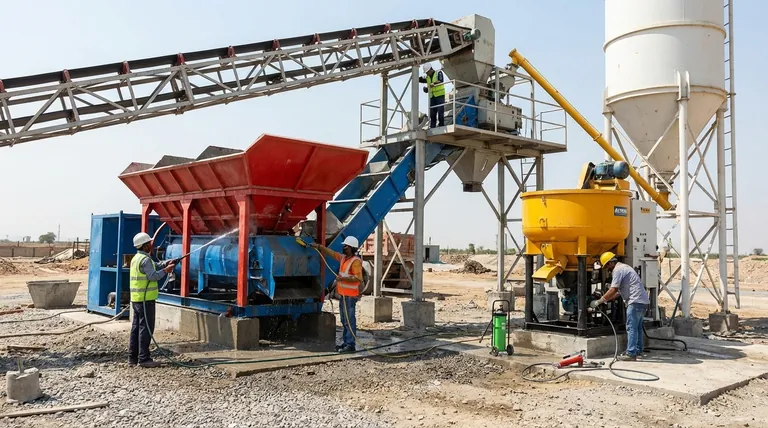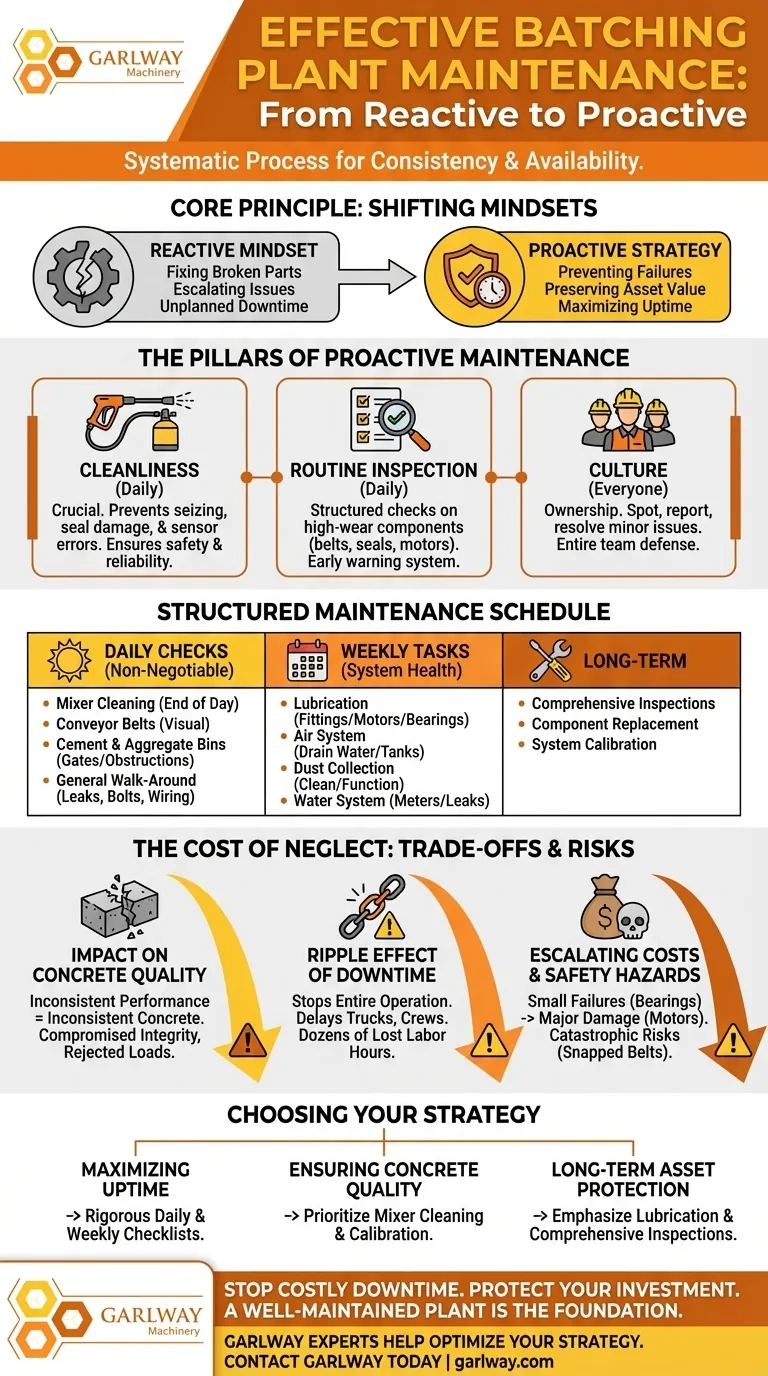Effective batching plant maintenance is a systematic process of daily cleaning, regular inspections, and immediate repair of any identified issues. It involves a disciplined approach to checking all key components, including conveyor belts, mixers, and electrical systems, for signs of wear or malfunction to prevent minor problems from escalating into costly downtime.
The core principle of batching plant maintenance is shifting from a reactive mindset of fixing broken parts to a proactive strategy of preventing failures before they happen. This preserves asset value, ensures product quality, and maximizes operational uptime.

The Pillars of Proactive Maintenance
A reliable batching plant is the heart of any concrete operation. Its maintenance isn't just about repairs; it's about creating a system that guarantees consistency and availability. This system rests on three fundamental pillars.
The Critical Role of Cleanliness
Hardened concrete is the primary enemy of a batching plant. Daily, thorough cleaning is not optional; it is the most crucial maintenance task.
Accumulated material can seize moving parts, damage seals, and throw off sensor readings. A clean plant is easier to inspect, safer to operate, and fundamentally more reliable.
The Power of Routine Inspection
What you can't see can shut you down. A structured inspection routine allows you to identify potential failures long before they occur.
This means visually and physically checking high-wear components every day. Worn belts, leaking seals, or unusual motor sounds are early warnings that must be addressed immediately.
From Checklist to Culture
Effective maintenance is more than a list of tasks; it's a culture of ownership. Every operator should be trained to spot, report, and (if appropriate) resolve minor issues.
When the entire team is invested in the health of the plant, you create a powerful defense against unexpected breakdowns.
A Structured Maintenance Schedule
To ensure nothing is missed, maintenance should be organized by frequency. This schedule covers the most critical areas of a typical batching plant.
Daily Checks (Non-Negotiable)
- Mixer Cleaning: The mixer must be thoroughly cleaned of all concrete and aggregate buildup at the end of every production day.
- Conveyor Belts: Visually inspect belts for tearing, misalignment, or excessive wear. Check that rollers are turning freely.
- Cement & Aggregate Bins: Ensure gates are opening and closing properly and are free of obstructions.
- General Walk-Around: Look for any leaks (air, water, hydraulic), loose bolts, or frayed wiring.
Weekly Tasks (System Health)
- Lubrication: Grease all required fittings on motors, bearings, and gates according to the manufacturer's schedule.
- Air System: Drain water from air compressors and tanks to prevent corrosion and pneumatic system failure.
- Dust Collection: Check and clean the dust collection system to ensure proper function and environmental compliance.
- Water System: Verify water meters are functioning correctly and that there are no significant leaks in pumps or lines.
Understanding the Trade-offs: The Cost of Neglect
Deferring maintenance might seem to save time or money in the short term, but it introduces significant risks that far outweigh any perceived benefit.
Impact on Concrete Quality
Inconsistent plant performance directly leads to inconsistent concrete. A poorly cleaned mixer can introduce hardened chunks into a fresh batch, compromising its integrity. Uncalibrated scales or water meters will result in batches that do not meet strength or workability specifications, leading to rejected loads and disputes.
The Ripple Effect of Downtime
A batching plant failure doesn't just stop the plant; it stops the entire downstream operation. Concrete trucks, pump operators, and finishing crews on multiple job sites are left waiting, creating a cascade of costly delays. An hour of plant downtime can translate into dozens or even hundreds of lost labor hours in the field.
Escalating Repair Costs and Safety Hazards
A small, inexpensive bearing that fails due to lack of grease can seize and destroy a much more expensive motor or gearbox. A worn conveyor belt that finally snaps can cause significant damage and poses a serious safety risk to personnel. Addressing issues when they are small is always safer and more cost-effective.
Making the Right Choice for Your Operation
Your maintenance strategy should align directly with your business goals.
- If your primary focus is maximizing uptime: Implement rigorous daily and weekly checklists, ensuring no routine task is ever skipped.
- If your primary focus is ensuring concrete quality: Prioritize the regular cleaning of the mixer and the calibration of all scales and meters.
- If your primary focus is long-term asset protection: Emphasize lubrication schedules and comprehensive inspections to extend the life of all mechanical and electrical components.
Ultimately, a well-maintained plant is the foundation of a profitable and reputable concrete supply operation.
Summary Table:
| Maintenance Frequency | Key Tasks |
|---|---|
| Daily | Clean mixer, inspect conveyor belts & bins, check for leaks/loose parts. |
| Weekly | Lubricate fittings, drain air systems, clean dust collectors, check water systems. |
| Long-Term | Comprehensive inspections, component replacement, system calibration. |
Stop costly downtime and protect your investment. A reliable batching plant is the heart of your operation. GARLWAY specializes in providing durable construction machinery, including concrete batching plants, mixers, and winches, for contractors and construction companies worldwide. Our equipment is built for performance, but proper maintenance is key to longevity. Let our experts help you optimize your maintenance strategy. Contact GARLWAY today to discuss your needs and ensure your plant operates at peak efficiency.
Visual Guide

Related Products
- HZS35 Small Cement Concrete Mixing Batch Plant
- HZS75 Concrete Batching Plant Cement Mixer Price Concrete Mixer Bunnings Mixing Plant
- HZS120 Ready Mix Concrete Batching Plant Commercial Mud Cement Mixer
- JW1000 Mobile Cement Mixer Concrete Mixer Truck and Batching Plant
- HZS180 Ready Mix Concrete Plant for Foundations with Sand and Cement
People Also Ask
- What are the factors influencing choice of a concrete mixing plant? Key Considerations for Efficiency
- What are the factors to be considered when designing a concrete mixture? Master the Balance for Strength & Workability
- What are the components of concrete mixing? Master the Ingredients and Machinery for Perfect Results
- How does a small cement mixer save money? Boost Efficiency & Reduce Labor Costs
- How does a small cement mixer improve time efficiency? Automate Mixing & Boost Productivity



















